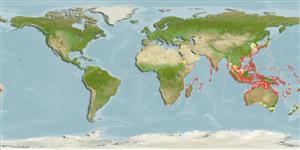Environment: milieu / climate zone / kisaran kedalaman / distribution range
Ekologi
laut berasosiasi dengan karang; kisaran kedalaman 1 - 55 m (Ref. 9710). Subtropical
Indo-West Pacific: tropical and subtropical waters, South Africa eastward through Indonesia; northward to southern Japan; southward to the east coast of Australia (Ref. 33352). Southeast Atlantic: south coast of South Africa.
Size / Weight / umur
Kematangan: Lm ? range ? - ? cm
Max length : 19.0 cm TL jantan/; (Ref. 9710)
deskripsi pendek
Kunci identifiaksi (pengenalan) | Morfologi | Morfometrik
Duri punggung (Keseluruhan (total)) : 2; duri punggung lunak (Keseluruhan (total)) : 43 - 50; Duri dubur: 0; Sirip dubur lunak: 41 - 46. Pale brown to grey in color; two brown stripes on body; adults with yellow spots on head and body; soft dorsal and anal fins yellowish; caudal fin dark brown (Ref. 4421).
Body shape (shape guide): fusiform / normal.
Inhabit coastal reefs and enter estuaries. Often in silty habitat and usually on slopes with low rubble reef and rich invertebrate growth, ranging to moderate depths (Ref. 48637). Found on weedy and sandy areas of lagoon and seaward reefs (Ref. 9710). Often found in pairs (Ref. 9710). Sometimes solitary or in groups (Ref. 90102). Juveniles hide or shelter near seawhips or seapens (Ref. 48637).
Life cycle and mating behavior
Kematangan | Reproduksi, perkembang biakan | Pemijahan | telur-telur | Fecundity | Larva
Masuda, H., K. Amaoka, C. Araga, T. Uyeno and T. Yoshino, 1984. The fishes of the Japanese Archipelago. Vol. 1. Tokai University Press, Tokyo, Japan. 437 p. (text). (Ref. 559)
Status IUCN Red List (Ref. 130435: Version 2025-1)
ancaman kepada manusia
Harmless
penggunaan manusia
Alat, peralatan
laporan khas
muat turun XML
Sumber internet
Estimates based on models
Preferred temperature (Acuan
123201): 22.4 - 29, mean 27.7 °C (based on 974 cells).
Phylogenetic diversity index (Acuan
82804): PD
50 = 1.0000 [Uniqueness, from 0.5 = low to 2.0 = high].
Bayesian length-weight: a=0.00955 (0.00501 - 0.01821), b=3.07 (2.90 - 3.24), in cm total length, based on LWR estimates for this species & (Sub)family-body (Ref.
93245).
Trophic level (Acuan
69278): 3.1 ±0.0 se; based on diet studies.
Daya lenting (Acuan
120179): Tinggi, Waktu penggandaan populasi minimum kurang dari 15 bulan (Preliminary K or Fecundity.).
Fishing Vulnerability (Ref.
59153): Low vulnerability (10 of 100).
🛈
Nutrients (Ref.
124155): Calcium = 38.9 [14.5, 124.6] mg/100g; Iron = 0.757 [0.328, 1.742] mg/100g; Protein = 19.2 [17.0, 21.4] %; Omega3 = 0.227 [0.099, 0.466] g/100g; Selenium = 13.9 [6.2, 32.8] μg/100g; VitaminA = 62.3 [20.9, 191.6] μg/100g; Zinc = 1.04 [0.65, 1.73] mg/100g (wet weight);
